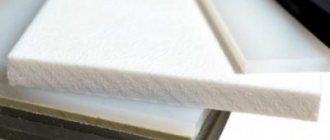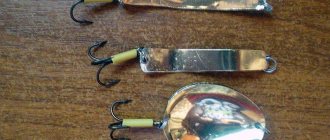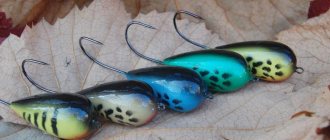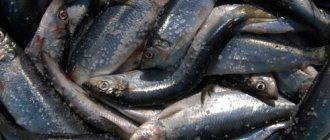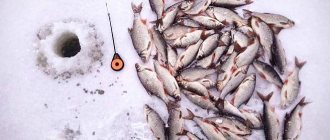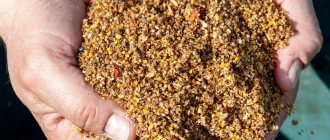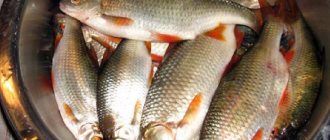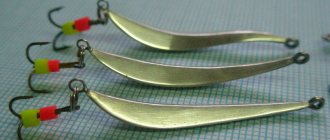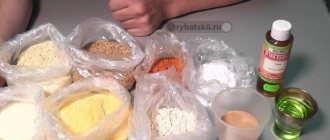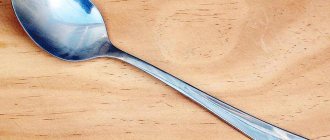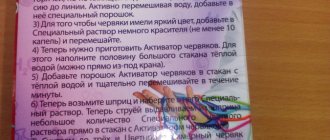Decoration of spinners
To make the bait more attractive, the angler can equip the spinner with additional accessories, as well as paint it in what he thinks is a promising color, or create a fine relief structure on the working surface of the spinner using engraving or fine notches.
The color schemes of the accessory are chosen based on the preferences of the predator in the fishing areas, but red, white and acid green colors are considered classics. Stringing two or three small bead shapes onto a tee, in addition to the color spot, gives an additional noise effect when wiring, which also often helps to activate the bite.
The presence in the angler’s arsenal of multi-colored markers with the ability to draw on metal will only be a help. By decorating the spoon and the petal of the spinner with stripes, or marking the working plane with dots, we can confidently talk about increasing the attractiveness of the bait for a predator. In addition, if the coloring of one option is unsuccessful, after washing it off with a solvent, the same spinner can be used in a different color scheme, thereby increasing the variability of fishing opportunities.
https://youtube.com/watch?v=MTvHiYsDqOc
As can be seen from the material, making spinners with your own hands is a creative process, not defined by the boundaries of fantasy, which is clearly beneficial to the angler and provides ample opportunities for making a specific fishing tool in order to implement the most daring fishing strategies, hoping for significant success.
Characteristics of the Tsar Fish spinner
The Tsar Fish spinner is something between a spinner and a castmaster. There are also some tricks in creation, which the master, by the way, happily divulges and does not keep secret.
So, to create a bait, a string is used, from which the first loop is made, called the top one. After which the petal and fairing are put on the string. Then the casmaster is attached. It has a distinctive hole that acts like a whistle. And thanks to the presence of a special bell, additional noise is created when the spinner is held under water. This sound attracts fish very much. The tee is attached to the body of the spinner using the well-known winding ring. These are all the tricks that are used when creating bait.
The Tsar Fish spinner takes three minutes to assemble. Before this, it takes some time to prepare the components. By the way, each product has a name on the petal.
What is a spinner spoon?
This is a bait for catching predatory fish, consisting of a curved strip of metal, rings, a swivel, and a treble hook. It is painted in various colors for use in specific fishing conditions.
The success of the bait is based on the use of the natural hunting instincts of fish, encouraging them to swallow the bait. To better imitate a prey, you need to choose the right spinner wiring to make it as attractive as possible. This is facilitated not only by its appearance, but also by the way it oscillates when moving, producing acoustic waves that are perceived by the lateral line of the predator.
How does the spinner behave when retrieved?
When fishing, the Tsar Fish spinner behaves quite noisily underwater. This can be seen by the vibrations of the rod tip. With its help, a powerful vibration is created, which attracts the attention of the fish and arouses interest. Thanks to this, Alexander Petrovich managed to catch a fish weighing 45 kilograms with his bait.
The master makes baits of different sizes. The President of the Russian Federation caught a pike using the largest spinner of the entire line. Among foreign manufacturers it is quite difficult to find a spinner of this size.
The inventor does not seek to patent his invention. He keeps all his best specimens and puts them on public display at presentations of fishing equipment.
The Tsar Fish spinner received its name during a meeting of the fishing club, where lovers of quiet hunting, through discussions, selected the most appropriate names for baits.
Advantages
The famous author of books on spinning fishing, Viktor Andreev, once described an interesting case. One day he and his friends came to the same lake to catch pike. Moreover, they came purposefully, since, according to the stories of other fishermen, these gray predators were visible and invisible in this reservoir. We settled down and took out branded spinners. They started throwing - nothing. Not a single loot. We were already getting ready to leave, and a guy came ashore with some kind of rusty homemade spoon, and let’s carry large pikes.
The fishermen couldn't believe their eyes. And the reason turned out to be simple. The fact is that in this lake pike are accustomed to hunting rotans. They are dark in color. And the city spinners arrived with branded shiny spoons, to which the pike did not react.
They had to urgently smoke their imported gear over a fire. Since then, according to the author, he became interested in homemade fishing equipment and now considers them his most favorite equipment.
Indeed, the advantages of homemade spinners include the following factors:
- you can make your own custom-made tackle, which will be catchy exactly in the body of water where you usually fish;
- it is not difficult to make from almost any available materials;
- financial costs are minimal;
- the manufacture of such gear is considered simple;
- the field for experimentation is simply huge;
- the number of fishing lures depends on your desire;
- such home production does not take much time;
- Finally, the small cost will not make you particularly sorry if the bait breaks - you will make another one.
How it all began with Alexander Petrovich
A previously little-known fishing enthusiast, Prokofiev Alexander Petrovich, after retiring, decided to devote more time to his hobby. After all, fishing was his hobby from early childhood. But in stores he found only imported samples of baits. This upset him somewhat, and he decided to create his own successful version of the spinner. After studying the properties and characteristics of foreign baits, he moved on to creating his own. His knowledge of engineering helped him a lot in this.
After some time, the Tsar Fish pike lure saw the light. The inventor lived on the banks of a river, so he carried out all the tests in an open body of water. After all, it is so important when creating a spinner to pay great attention to all the nuances: the placement of the center of gravity, shape, design.
After testing the bait by Alexander Petrovich himself, friends and acquaintances began testing it. The spinner impressed many people, became in demand, and the inventor’s wife also joined its production.
At first, the Tsar Fish spinner was made right in Alexander Petrovich’s apartment. Later, a small machine for the production of spinners was made. After which their production became the family business of the Prokofiev family.
Brass - for “yellow” spinners
“Yellow” spoons are also very important. It has long been known that predators (in particular, pike and pike perch) prefer “white” spoons on some days, and “yellow” ones on others. Even in Soviet times, there were stories among children: they say, “white” spoons are for clear sunny days, and “yellow” ones are for rainy, cloudy days.
In reality, this is not always the case. On the contrary, on clear sunny days, the glare on “white” spoons can scare away a predator, but “yellow” spoons can help out on such a day. But, in any case, you should never rely only on white spoons. A fisherman’s collection must also include “yellow” spinners.
What material should I use to make “yellow” spinners? Here the best option is brass. Brass is a very good, strong, tough “yellow” metal. Maybe you've ever had brass dishes (all kinds of basins were especially popular)?
Then you know how strong and unbending this metal is. For the manufacture of spinners, factory-made brass sheets with a thickness of only 0.3-0.5 mm are perfect. From these thin sheets of metal you can make very miniature baits that will perfectly retain their shape and, accordingly, will play well.
There is, of course, another “yellow” metal that is well known to us - tin (in fact, this is, of course, steel, and not a separate type of metal - but let’s omit the details). Each of us has tin cans - coffee cans, olive cans, etc. This is also a very beautiful and attractive metal for predators. But he's too fat. The thickness of the tin is from 1 mm, and only the most greedy and hungry predators will be caught with such spoons.
Vladislav Ivanchenko - Especially for Homemade FISH, Ukraine, Kyiv
Turntables
The basis of a rotating spoon is a metal rod; elastic steel wire is most often used as it.
- A small loop is formed at the end of the wire.
- A winding ring under the tee is attached to it.
- A load is mounted above the loop. It can be done with a set of pellets, or you can wrap the rod with soft wire, for example, copper.
- The load is closed with a piece of heat-shrinkable tubing of a bright color, most often red.
- A sliding bead is placed above the load.
- A clamp with a petal is mounted above it.
- The petal itself is made from a plate of non-ferrous metal sheet.
- Another bead is placed above the collar and a second ring is formed for attaching to the leash.
The petal is cut in the form of a willow leaf such as “Aglia long”, “Indiana”, “Mepsa” or “Colorado”. Its performance depends on this. You can change the operation and attractiveness of a rotating spoon using other devices:
- front loading in front of the petal;
- adding a microturbine to the axle;
- decoration of a tee made of wool;
- changing the type of core.
Oscillating spoons
This type of bait is widely used when fishing for pike. They are made from curved metal plates, shiny or painted, with a hook attached to them (movable or fixed).
- The most widespread and easiest to make version of a homemade spinner is a bait made from the handle of a steel or cupronickel silver tablespoon. The shape necessary to increase catchability is achieved by bending the handle of the former spoon at both ends. Both spinner attachments (for fishing line and hook) are ordinary holes made with a drill. Cut 1.5-2 centimeters from the handle on the thin side, so it looks like a medium-sized stick. The tee is installed on the wide end of the spoon handle.
- From the remaining part of the teaspoon (without the handle). The remaining part of the spoon is sanded with a file at the cut point. Two holes are drilled. That's it - a perfectly symmetrical spinner with a recess is ready. For good bait retrieval, the ring connecting the spoon to the tee should be 1.5-2 times larger than the hook ring.
- An exclusive analogue of the expensive Devon spinner is made from the handle of an aluminum spoon. The manufacturing process completely repeats that for a heavy teaspoon, only the tee in this case is installed on the narrow part of the future spoon. This will prevent the spoon from jumping out of the water during the reeling process. By additionally increasing the bend, you can increase the liveliness of the vibrator.
- From an aluminum teaspoon (without handle). Produced in a similar process to steel billets. Unlike the heavy version, the aluminum spoon spoon has the interesting effect of creating additional sound when retrieved. For pike this is a good additional irritant.
- A symmetrical oval or diamond-shaped plate in the form of a medium-sized bleak fish, with a hole for fishing line, is cut out of brass or copper blanks. By extrusion or embossing, the plate is given the required shape with the required bends. One side of the plate is covered with soldering solder, which secures the hooks and weighs down the lure. The second side is carefully sanded. Cast or turned blanks can be used as blanks, and then the process of making the spoon will consist of drilling holes and attaching hooks.
- A bimetallic spinner is made of two metals (galvanic pair). The best, but unfortunately not the most durable, option would be a copper-aluminum combination. Two identical blanks are made with holes for winding tracks and rivets. The blanks are riveted and processed with a file until the spoon of the desired shape is obtained. Then stamping produces the desired geometry of the oscillator. The surface is carefully sanded and polished.
- A tubular spoon is made from a metal tube of a suitable size. The tube is cut on both sides at different angles, processed and polished. The fishing line is attached to the blunt end of the tube so that the spinner yaws while fishing, imitating a rushing fish.
- A tubular composite spoon will provide even greater “play” and yaw on the water. The design of a complex spinner usually consists of three parts, movably connected to each other. The bends of such a spoon make it almost indistinguishable from the movements of a live fish.
- Corrugated spoons can be made either by embossing (embossing) or from ready-made corrugated plumbing pipes. Blanks of the desired shape are cut out, holes are drilled in them for attaching the fishing line and tee. Such spoons often turn out to be very catchy.
- Ultralight micro-oscillators are made similarly to options 5 and 6 and differ only in the thoroughness of processing. The edges of the spoon are rounded with a file and the thickness of the metal on the outside is reduced to nothing. Then the surface is cleaned with fine sandpaper and polished.
Decoration of spinners
Plumage.
The beauty attached to the tee part of the spoon performs a very specific role: it makes the bait larger and more attractive for such a predator as pike. Possible variants of spinners with a vibrating tail (twister), with tinsel, with a silicone skirt, and with a bright woolen thread.
An additionally colored spinner makes the bait more attractive and catchy. It is enough to simply mark the eye of the fish, draw transverse stripes or paint one side in a contrasting color, leaving the other light, and an increase in the number of bites is guaranteed.
How to make a spinner with your own hands?
Making a spinner yourself is not as difficult as it might seem. To do this, you only need a small set of plumbing tools, suitable material and a little effort. The material can be stainless steel, copper, brass, aluminum or bronze, but, unfortunately, in our capitalist times this is no longer lying around, so there is nothing left but to use some simple objects familiar to everyone. Which ones exactly? Now let's find out:
- Spoon spoon. A dining room, a tea room, a dessert room... any of these products is suitable for making an oscillating spoon, usually for catching pike. To begin with, you need to saw off (bite off, break off) the handle of the cutlery, resulting in an excellent workpiece. The scoop (that’s what this part is called) should be made more like a fish. To do this, it is bent and even processed with a file, if necessary. When the workpiece takes the desired shape, holes for the winding rings are drilled on both sides. A swivel with a fastener is installed on the narrow end, and a tee is installed on the wide end, which is selected depending on the thickness of the metal. If the treble hook is too heavy, it will negatively affect the performance of the homemade bait. Each fisherman decides for himself how to decorate the lure. Some simply polish it to a mirror shine, others paint or glue glitter on it. If you have a large arsenal of spoons at home and the housewife doesn’t know exactly how many there are, then you can make many different options. At the same time, you shouldn’t get too carried away, otherwise sooner or later she will notice the shortage and guess where the devices went.
- Spinner from a tube. Metal corrugation with a diameter of 2-3 cm makes excellent ribbed vibrators that can provoke any predator to grab it. To make three such spinners, you will need a piece of tube 7-8 cm long. It needs to be cut lengthwise into three equal parts, and then the edges of the resulting blanks must be sanded. One side of the workpiece is straightened, and the other, which remains concave, needs to be etched with acid and a little tin soldered to it to make it heavier. The total weight of the bait depends on the amount of this metal. Then everything is as usual - we drill holes at the ends and make rings.
- Cap from a beer bottle. This is the simplest option that even a schoolchild can handle. The body of the bait in this case is a metal cap from lemonade, Pepsi or beer. You need to put several hunting pellets in it and squeeze it with pliers so that the lead balls are inside. It turns out to be something like a noise chamber. The shot will perform two tasks at once: it will make the bait heavier and will create an attractive noise during the retrieve. The corners of the bent lid need to be slightly hammered so that they become flat. This will make it easier to drill holes and insert rings into them.
- A piece of tin. From this thin metal you can make a completely working turntable. If there is no tin, any other sheet metal with a thickness of no more than 0.6 mm will do. A petal of the required size is cut out of it and a hole is drilled in it on one side. Of course, a flat petal will not create enticing vibrations in the water, so it should be given a slightly convex shape. To do this, the workpiece is placed on dense rubber and bent in the center with gentle blows to the bearing ball.
By the way, a petal with a ready-made convexity is obtained from a can of stewed meat or canned food. The next step is preparing the rod. This element is made from a piece of steel wire. First, lead beads and a miniature collar with a petal are put on it, and then loops for rings are twisted at the ends of the rod. If the petal will not be covered with bright red, colored varnish or a special film, then it should first be properly sanded.
- Coin spinner. An iron ruble or fifty dollars is an excellent material for making oscillating spinners. True, in order to roll them out to the desired shape, you have to really take risks. Once upon a time, fishermen made spoons from coins, placing them on railroad tracks. A train passed over the metal money and rolled it into thin ovals. This is an almost ready-made spoon, you just need to bend it using the same bearing ball and drill holes. Whether this trick is worth repeating is up to you to decide. If you're lucky, the blanks for the spinners will be ready in a couple of seconds; if not, then at best you'll get off with a warning from the railway police.
Types of tube spinners
The invaluable fishing experience of their ancestors in making baits gave their contemporaries the opportunity to make the following types of tubular spinners at home:
- Hollow homemade products. Thanks to its slight lateral maneuverability, which makes it possible to make fast retrieves, a tubular spoon of this type is used when catching freshwater predators at depth (in the bottom layers) or in strong currents.
- Tubular lures with a sealed top. This type is not as popular as the previous one, since when retrieving the bait, it can deviate by 30 - 40 cm from the main course due to high drag. However, in the dead of winter, when the predator is almost in suspended animation, this homemade product will definitely stir it up when guiding it with its characteristic prowling game and the sound that the hollow back of the bait makes.
- Loaded baits. They are used even less frequently - only when fishing conditions require long casting, as well as during strong gusts of wind. The distinctive features of such baits are that the body of the spoon itself is half or one third filled with lead.
- Noise homemade product. Another popular modification of tubular spinners. This type of spinner made of a copper tube or other material is distinguished by the fact that both ends are sealed with lead or solder. For a characteristic sound effect, before sealing the ends of the tube, a lead pellet is placed into the cavity. The rattling sound produced by the homemade bait when retrieving it provokes the predator to attack.
- Compound lures. From the point of view of the technological process, these are the most complex baits, usually consisting of 3 segments. However, the time spent on making composite spinners will pay off many times over. The homemade product is incredibly catchy, since in addition to the main game, when retrieving, the bait oscillates (bends, straightens) in the likeness of a real fry.
Photo 1. Hollow spinner tube.
Photo 2. Whole-bodied spoon.
Important! Stepped wiring is the most suitable option for homemade tubes. Active twisting of the reel, alternating with pauses, makes the animation of the bait as two peas in a pod as similar to the behavior of a real fry that is injured or weakened
This greatly excites the predator.
Spinner for fishing in muddy water
Before starting production, you should determine the nature of the muddy water and whether fish can live in this water. The water can be so cloudy and dirty that it is unlikely that any fish other than crucian carp can survive in it. The purpose of the bait is to attract fish and provoke them to bite.
If the water is clean and transparent, then the fish sees the bait at a great distance. If the water is cloudy, then the fish have certain difficulties identifying the bait. For such conditions, it is necessary to make a bait from a special, shiny material.
For production you will need:
- It is better to take a chrome pipe as the main material, which will have to be cut in half.
- Knife or scissors for working with metal.
- Sandpaper.
- Drill.
- Soldering kit: soldering iron, solder and acid.
Manufacturing technology
- The prepared blank from a piece of chrome-plated pipe is brought to perfection. In other words, it needs to be shaped like a spoon. The workpiece may need to be bent or slightly straightened.
- The bait is cut strictly according to the template.
- It is better if the shape of the workpiece resembles a small fish.
- A hook is attached to the wider end of the workpiece using soldering.
- The edges of the workpiece should be thoroughly cleaned with sandpaper, otherwise the line may break upon contact.
- A hole is drilled on the narrower part and a winding ring is inserted.
- The spoon is ready for use. If necessary, it can be sanded a little with GOI paste.
Reviews of the Tsar Fish lure
Thanks to the feedback from fishermen and specialists, we can draw some conclusions about the described bait. These lures are catchy, since their inventor tests everything himself, and if anything does not spin as it should, the bait is remade. The Tsar Fish spinner, which has only rave reviews, is unique in its design.
True, some fishermen note its high cost. If the reservoir is snagy, then with significant snags and cliffs, fishing will hit your pocket hard. But many amateurs liked spinners, and they enjoy fishing with them. How many people, so many opinions. One thing can be said that the work of the inventor of the Tsar Fish spinner is worthy of respect and recognition.
Final processing and fine-tuning of the micro-oscillator
Using fine-grained sandpaper, we remove all scratches and irregularities from the metal, and then using GOI paste and felt (say, from an old overcoat or felt boot) we bring the micro-oscillator to a shine. It is worth pointing out that shine, especially mirror shine, is not in all cases useful for our small ultralight lures. Therefore, the surface can be left treated only with sandpaper, then it becomes matte. To remove excessive glare, I use a fine notch, or rather, scratches on the body of the micro-oscillator. Which I do using the same needle or drill. In principle, the micro-oscillator can be left unprocessed at all; this will not interfere - taking into account, of course, our correct actions - from catching fish regularly with it, but in terms of aesthetic perception, such a micro-oscillator, if I may say so, is unlikely to evoke positive emotions in us. For nothing it bites.
It is not prohibited to use micro-vibrations and multi-colored alcohol markers for painting, but I use them very rarely, and even then only for applying contrasting dots or stripes. If microoscillators are made of copper, I prefer not to process them at all, I just apply notches. Yes, for beauty.
Spinner "Tsar Fish" and its wide popularity
A large amount of information about the Tsar Fish lure has appeared on the Internet. What is she? What brought her such great popularity?
The Tsar Fish spinner was practically unknown among fishermen. Only a small number of people from Krasnoyarsk who are interested in fishing knew about its existence. One incident brought popularity and worldwide fame to the lure. This event occurred in July 2013, when the head of the Russian state went on vacation. A place where one could escape from the bustle of the city was chosen that was rarely visited - in the Tuva region. There is a picturesque lake nearby, where Vladimir Putin decided to go fishing with a spinning rod.
The spoon used for this was made by a local craftsman. And it met all expectations - a fish weighing 21 kg bit on it! These were the most exciting minutes the president spent fishing, since he had never come across such impressive specimens before.
After gutting the fish, it became clear that she was not hungry, but rushed to the bait only because she was very attracted to it by its appearance.
Materials and tools for making a tube spoon
When choosing materials for spinners, the fisherman is inexhaustible in his inventions, but the main semi-finished products for their manufacture are the following products:
- Various sizes of metal spoons. Their shape and material are almost ideal for making this kind of bait. Sometimes it is enough to cut the handle, drill two holes and equip the product to get a finished spoon.
- Coins of various denominations. In quantities of 3-5 pieces, they are connected into a single chain with rings through holes.
- Tubes made of brass, copper, stainless steel and other materials, cut at a bevel.
Important! There is a danger of injury - you need to dull the sharp edges and sand the edges. A self-made spinner tube for pike perch or any other freshwater predator will require the following materials:
A self-made spinner tube for pike perch or any other freshwater predator will require the following materials:
- aluminum or copper tubes;
- lead rods or solder;
- abrasive material (fine sandpaper for final polishing);
- swivels, winding rings, tees, stabilizer fins.
Photo 3. Elements of the spinner.
Blitz advice
To further refine the color scheme and pattern of the resulting lure, you can use multi-colored permanent markers, nail polishes, etc. Everything is limited only by imagination.
Experienced fishermen appreciate homemade tackle. For example, making a spinner with your own hands is a kind of mastery of a special art. Although this activity is not very difficult and does not require large expenses.
But now in Russia there are many real enthusiasts and masters of this business, and a lot of options for such spinners have appeared. And many of them are much more catchy than the most expensive branded ones, because they are adapted specifically to a given fishing location and to the specific predatory fish living in that reservoir.
